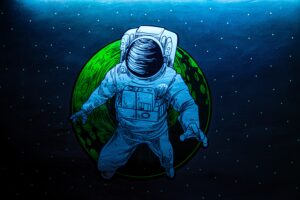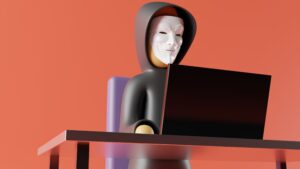
An NFT, or non-fungible token, is a digital asset that represents a physical object, such as the Charlie Bit My Finger video, which sold for £500,000 in May. NFTs are typically purchased and sold online using cryptocurrency, and are generally encoded with the same underlying software as many cryptocurrencies.
Despite the fact that they have been around since 2014, NFTs are gaining popularity as a popular way to buy and sell digital artwork. Since November 2017, a staggering £123 million has been spent on NFTs.
NFTs are also typically one-of-a-kind, or at the very least one of a very limited run, with unique identifying codes. “Essentially, NFTs create digital scarcity,” says Arry Yu, managing director of Yellow Umbrella Ventures and chair of the Washington Technology Industry Association Cascadia Blockchain Council.
This is in sharp contrast to the vast majority of digital creations, which are almost always infinite in supply. Cutting off supply should theoretically increase the value of a given asset, assuming it is in demand.
However, many NFTs, at least in the early days, were digital creations that already existed in some form elsewhere, such as the viral Charlie Bit My Finger video or securitised versions of digital art that was already floating around on Instagram.
For example, famous digital artist Mike Winklemann, better known as “Beeple,” created perhaps the most famous NFT of the moment, “EVERYDAYS: The First 5000 Days,” which sold at Christie’s for nearly £50 million.
Individual images—or even the entire collage of images—can be viewed online for free by anyone. So, why are people willing to spend millions of dollars on something that can be easily screenshotted or downloaded?
Because an NFT allows the buyer to retain ownership of the original item. Furthermore, it includes built-in authentication, which serves as proof of ownership. Collectors value “digital bragging rights” nearly as much as the item itself.

How Do NFTs Work?
NFTs are created through a process known as minting, in which the NFT’s information is published on a blockchain. At a high level, the minting process involves the creation of a new block, the validation of the NFT’s information by a validator, and the recording of the information. This minting process frequently includes the incorporation of smart contracts that assign ownership and manage the NFT’s transferability.
Tokens are issued with a unique identifier that is directly linked to a blockchain address. Each token has an owner, and the owner’s information (i.e. the address where the minted token is kept) is public. Even if 5,000 NFTs of the same item (for example, general admission tickets to a music festival) are minted, each ticket has a unique identifier and can be distinguished from the others.

Fungibility and Blockchain
From a financial standpoint, cryptocurrencies, like physical money, are usually fungible, which means they can be traded or exchanged for one another. For example, on any given exchange, one bitcoin is always worth the same as another bitcoin, just as every dollar bill in the United States has an implicit exchange value of $1. Because of this fungibility, cryptocurrencies are suitable as a secure medium of transaction in the digital economy.
However, due to the ability of blockchain to store and publicly communicate transaction history, not every token or coin of a given cryptocurrency is the same. People may pay a premium, for example, to own a bitcoin previously owned by Elon Musk or a coin that has never been traded before. Collectors are willing to pay much more for something unique, similar to how a 1944 U.S. steel wheat penny is only worth $0.01.
Because of this, NFTs change the crypto paradigm by making each token unique and irreplaceable, making it impossible for one non-fungible token to be equal to another. They are digital representations of assets that have been compared to digital passports because each token contains a unique, non-transferable identity that allows it to be distinguished from other tokens. They are also extensible, which means that you can combine one NFT with another to create a third, distinct NFT.

Why Are NFTs Important?
Non-fungible tokens are an evolution of cryptocurrency’s relatively simple concept. Modern finance systems are made up of sophisticated trading and loan systems for various asset types, such as real estate, lending contracts, and artwork. NFTs advance the reinvention of this infrastructure by enabling digital representations of physical assets.
To be sure, neither the concept of digital representations of physical assets nor the use of unique identification is novel. When these ideas are combined with the advantages of a tamper-proof blockchain of smart contracts, they become a powerful force for change.
The most obvious advantage of NFTs is market efficiency. Converting a physical asset to a digital asset streamlines processes and eliminates intermediaries. NFTs on a blockchain representing digital or physical artwork eliminate the need for agents and allow artists to connect directly with their audiences. They can also be used to improve business processes. An NFT for a wine bottle, for example, will make it easier for different actors in a supply chain to interact with it and will aid in tracking its provenance, production, and sale throughout the entire process. Ernst & Young, a consulting firm, has already developed such a solution for one of its clients.
Non-fungible tokens are also great for managing identities. Consider the case of physical passports, which must be produced at every point of entry and exit. Individual passports can be converted into NFTs, each with its own unique identifying characteristics, allowing jurisdictions to streamline entry and exit processes. Expanding on this use case, NFTs can also be used for identity management in the digital realm.

NFTs in the Physical and Virtual Environments
By fractionalizing physical assets such as real estate, NFTs can also democratise investing. A digital real estate asset is much easier to divide among multiple owners than a physical one. That tokenization ethic does not have to be limited to real estate; it can also apply to other assets such as artwork. As a result, a painting does not always have a single owner. Its digital counterpart can have multiple owners, each of whom is responsible for a portion of the painting. Such arrangements could boost its value and revenue.
The creation of new markets and forms of investment is the most exciting possibility for NFTs. Consider a piece of real estate divided into multiple divisions, each with its own set of characteristics and property types. One division may be near a beach, another in an entertainment complex, and yet another in a residential district. Each piece of land is unique, priced differently, and represented by an NFT based on its characteristics. The incorporation of relevant metadata into each unique NFT can simplify real estate trading, which is a complex and bureaucratic affair.
Decentraland, a virtual reality platform built on Ethereum’s blockchain, has already put this idea into action. As NFTs become more sophisticated and integrated into financial infrastructure, the same concept of tokenized pieces of land (varying in value and location) may become feasible in the physical world.

What Are Some Non-Fungible Token Examples?
Non-fungible tokens can be used to digitally represent any asset, including online-only assets such as digital artwork and physical assets such as real estate. In-game items such as avatars, digital and non-digital collectibles, domain names, and event tickets are other examples of assets that NFTs can represent.
How Can I Purchase NFTs?
Because many NFTs can only be purchased with Ether, having some of this cryptocurrency and storing it in a digital wallet is usually the first step. You can then buy NFTs from any of the online NFT marketplaces, such as OpenSea, Rarible, or SuperRare.

Are NFTs secure?
Non-fungible tokens, which use blockchain technology in the same way that cryptocurrency does, are generally safe. NFTs are difficult (but not impossible) to hack due to the distributed nature of blockchains. One security risk associated with NFTs is that you may lose access to your non-fungible token if the platform that hosts the NFT goes out of business.
What Does the Term “Non-Fungible” Mean?
Fungibility is a term used in economics to describe the interchangeability of certain goods. A barrel of oil, for example, is fungible (interchangeable/indistinguishable) from any other barrel of oil. A dollar bill is also equal to any other dollar bill (or 4 quarters, etc.). To make such items unique or distinguishable, they must be non-fungible. For example, if a dollar bill is drawn on and signed by a famous artist, it becomes unique – unlike all other dollar bills – and may be worth more than its face value.

In Conclusion
Non-fungible tokens are one-of-a-kind digital representations of assets that exist on a blockchain. As the world investigates how distributed, immutable ledgers can make transactions safer and faster, NFTs play an important role. These assets have a preserved transaction history, the potential to streamline trade, and are a cornerstone in the emerging digital world.